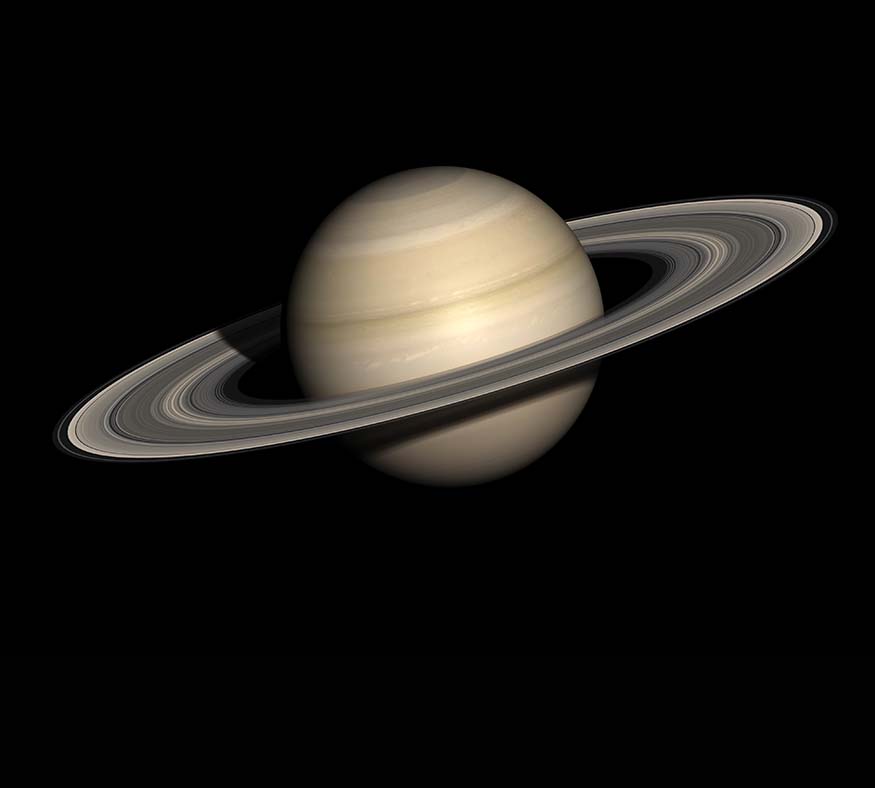
BEAUTY: 
BRAGGING RIGHTS: Must see
HOW EASY IS IT TO SEE? Best with small telescope
TYPE: Planet
DISCOVERED: Known since antiquity
On any clear night you can look out into space and see some of the planets that share our little solar system. You don’t need any special equipment—all you need is to know how to recognize a planet when you see one. There’s an easy trick for this: When you see a bright star in the sky, notice whether the star is twinkling or not. If the star is not twinkling, then chances are, you’re looking at a planet. That’s all there is to it. With that one bit of knowledge you can see the sky in a whole new way, and every time you see a planet you will feel as if you’ve glimpsed a secret in plain sight.
With even a small telescope, these wandering points of light turn into new worlds. Many planets are visible in the night sky, but one is usually the first target for new stargazers: Saturn! And why shouldn’t it be? If you haven’t seen Saturn’s rings with your own eyes, you’re missing out. Seeing a picture of Saturn (even a high-resolution one from a spacecraft) just isn’t the same as seeing the real planet through a telescope.
When Galileo looked at Saturn through his telescope, he didn’t know what he was seeing! Saturn looked like it had two blobs sticking out the side, like ears. His telescope was too small and crude to see much detail. Your view through binoculars might not be too different. But the higher magnification of even a small modern telescope will start to reveal the rings in all their glory.
WHAT YOU MIGHT SEE THROUGH AMATEUR EQUIPMENT
Obviously, larger telescopes will provide larger, clearer images, but no matter what gear you use, when the planet finally snaps into focus, it’s breathtaking.
“Planet” means “wanderer.” The Big Dipper returns to our winter skies at the same time every year, but planets like Saturn wander through the constellations on their own cycles. Use the chart on the next page to locate Saturn based on the year and season. You’ll know you’ve found it when you see a pale-yellow, unblinking star of moderate brightness. Saturn doesn’t shine as brightly as Jupiter or Venus, but it should still be brighter than most stars.
Saturn’s rings! As Saturn moves through its orbit, our view of its rings changes. Some years we see them edge-on, as a thin, bright line crossing Saturn’s disk. Other years the rings open up and the full beauty of the planet becomes clear. In 2017 the rings will be at one of their widest points, but even on average years the view is magnificent.
At 100× magnification, easily reached with a small telescope, the shadow of the rings on the planet gives the whole view a three-dimensional quality. Seeing Saturn this way for the first time is enough to make you gasp.
Take a closer look at the rings. Though the rings look solid, they are actually composed of billions of icy particles, most no bigger than dust motes, but some as big as a car. The tidal forces of Saturn’s many moons herd these tiny particles into complex rings.
At 200× magnification you might find a dark band at the outer edge of the rings. This is called the Cassini Division, named after its discoverer, Giovanni Cassini. It’s actually a gap in the rings—the largest of thousands of little gaps.
Now compare the rings on either side of the Cassini Division. Does the inner ring look brighter? This ring has a greater density of icy particles, and thus reflects more light than the others.
Saturn’s storm belts. Jupiter’s high-contrast storm bands are easier to see, but if you look carefully through a telescope, you can spot subtle bands on Saturn too. At the planet’s equator you might see thin little bands, slightly darker than the rest of the disk. You might also notice dark areas at the poles, almost like dark polar caps.
|
DATES WHEN SATURN IS AT OPPOSITION AND WHERE TO LOOK |
|
DATE |
CONSTELLATION |
June 15, 2017 |
Ophiuchus |
June 27, 2018 |
Sagittarius |
July 9, 2019 |
Sagittarius |
July 20, 2020 |
Capricornus |
August 2, 2021 |
Capricornus |
August 14, 2022 |
Capricornus |
September 8, 2024 |
Aquarius |
September 21, 2025 |
Pisces |
October 4, 2026 |
Cetus |
October 18, 2027 |
Pisces |
If you haven’t seen Saturn’s rings with your own eyes, you’re missing out.